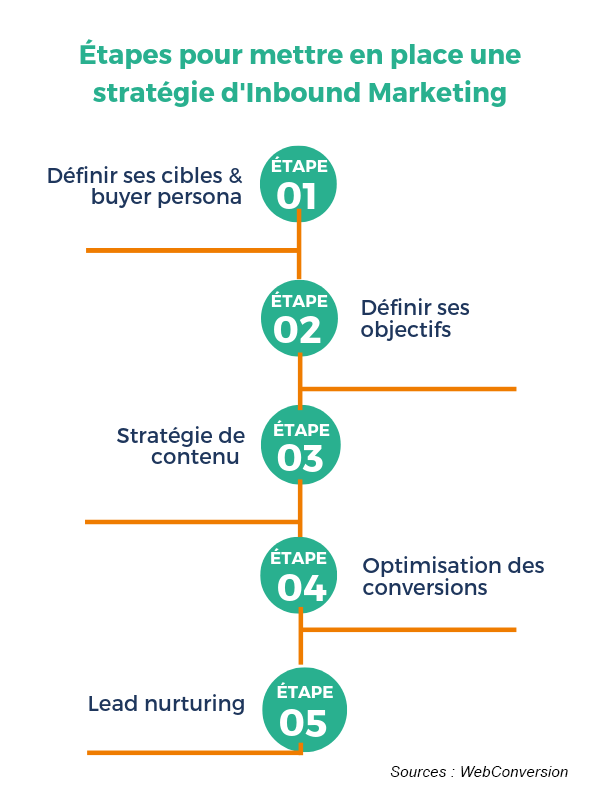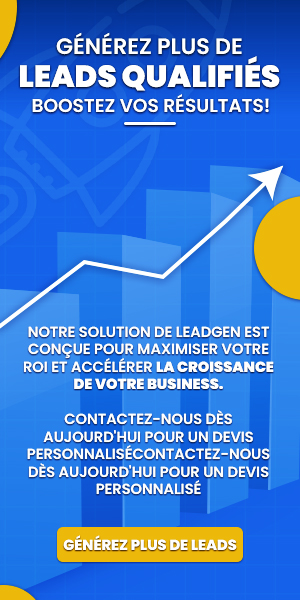Inbound Marketing is an innovative approach that transforms the way businesses attract, engage and convert potential customers. Unlike traditional marketing methods which rely on intrusive techniques, this strategy revolves around the creation of relevant and quality content, aimed at meeting the needs and expectations of prospects. By focusing on user experience and establishing trusting relationships, Inbound Marketing is revolutionizing business strategies by promoting the generation of qualified leads and optimizing the customer journey. Through the use of digital tools and automation, businesses can not only improve their visibility, but also refine their approach to maximize conversions and build customer loyalty.
Table des matières
ToggleFundamentals of Inbound Marketing

L’Inbound Marketing is based on the idea of attracting potential customers by providing them with quality content that meets their needs and expectations. Instead of focusing on intrusive methods like traditional advertising, this approach aims to build an authentic connection with consumers.
The basic principles of Inbound Marketing are as follows:
- Attraction : Capture the attention of prospects through engaging content such as blog articles, videos, or infographics.
- Conversion : Transform visitors into qualified leads using forms, downloadable offers or compelling calls to action.
- Commitment : Maintain lead interest through personalized communications, such as newsletters or email campaigns.
- Loyalty : Nurture leads through regular monitoring and relevant content to convert them into loyal customers.
Understanding these principles allows companies to build a strategy that truly interests their target audience. By positioning themselves as a reliable source of information, they strengthen their credibility and promote a lasting bond with their customers.
The effectiveness of Inbound Marketing also lies in its approach based on data. By analyzing user behavior, businesses can adjust their content and communication channels, maximizing the impact of their marketing efforts.
Finally, theInbound Marketing encourages a culture of continuous improvement. Thanks to A/B testing and regular performance auditing, companies can refine their strategy to optimize lead generation and return on investment.
Attract visitors with quality content
Inbound Marketing is based on the idea of naturally attracting customers to your business, rather than trying to reach them through intrusive methods. This process is based on the creation of interesting content and of value, likely to answer the needs and questions of your target audience.
With emphasis on the attraction prospects, Inbound Marketing transforms traditional commercial strategies by promoting a softer and more engaging approach. This involves deeply understanding your audience and using the right techniques to capture their attention.
One of the key principles of Inbound Marketing is toattract visitors with quality content. This content can take several forms:
- Blog posts informative and engaging to answer user questions.
- Infographics presenting important data in a visual and engaging way.
- Videos explanations that simplify complex concepts.
- White Papers and practical guides to delve deeper into a specific subject.
The objective is to create a content ecosystem that attracts, engages and converts visitors into customers. Each piece of content should be designed around the needs and expectations of your target audience, to maximize its impact.
In summary, Inbound Marketing is an effective model that, when implemented correctly, can transform the way you attract and convert leads while building lasting relationships with your customers.
Transform prospects into loyal customers
L’Inbound Marketing is an approach that aims to attract potential customers through quality content, personalized interactions and a real understanding of the needs of the target audience. Unlike more traditional marketing methods, inbound marketing focuses on creating an authentic relationship with prospects.
The fundamental principles of this strategy are based on three major pillars: attract, convert And enrich. Each of these elements plays a crucial role in transforming a prospect into a loyal customer.
Attract involves driving organic traffic to your platforms by creating relevant and eye-catching content, such as blog posts, videos or infographics. By targeting topics that interest your audience, you establish authority in your field.
The phase of conversion is to transform these visitors into leads using forms, calls to action (CTAs) and attractive offers. Once the user shares their information, they become a lead and you can start qualifying them further.
For enrich relationship with your leads, it is important to provide personalized follow-up. This can be achieved through targeted emails, tailored offers, and additional resources that meet prospects’ specific needs.
The efforts ofInbound Marketing bear fruit in the long term. Transforming prospects into loyal customers involves:
- Understanding the needs and behaviors of leads.
- The creation of fluid and coherent customer journeys.
- Setting up a feedback system to constantly improve your offers.
- Promoting customer testimonials to consolidate trust.
This process is reinforced by analysis and monitoring tools, making it possible to constantly adjust the commercial strategy based on market feedback. With a user-centered approach, theInbound Marketing becomes an engine of sustainable growth for any company.
Implementation of an Inbound Marketing strategy
#InboundMarketing 🎴 Rencontrez-vous des problèmes courants avec votre stratégie inbound marketing ? 🚀
— Audrey Tips (@audreytipsfr) August 2, 2024
🔍 Voici comment générer des leads de qualité, créer du contenu engageant et suivre vos performances 🌟
•#LeadGenerationhttps://t.co/BbOq227IRc
L’Inbound Marketing is an approach that aims to attract potential customers by creating relevant and valuable content. Unlike traditional marketing methods, which often rely on interruptions,Inbound Marketing strives to grab the attention of prospects and engage them in a natural buying journey.
Implementation of a strategyInbound Marketing requires several key steps that guarantee its effectiveness:
- Define buyer personas: Identify the different types of target customers, their needs, their behaviors and their challenges.
- Create quality content: Develop blog posts, white papers, videos, and infographics that answer user questions and concerns.
- Optimize natural referencing (SEO): Use relevant keywords and SEO techniques to ensure content is easily findable by search engines.
- Promote content: Share content on social media, via newsletters and other channels to reach a wider audience.
- Convert visitors into leads: Implement contact forms, effective calls to action (CTAs) and dedicated landing pages to capture visitor information.
- Retain leads: Use marketing automation tools to personalize communications and track lead engagement over time.
- Analyze the results: Use analysis tools to evaluate the performance of the strategy and adjust actions based on the data collected.
L’Inbound Marketing helps build a relationship of trust with consumers. By continually providing useful and relevant information, businesses can increase their visibility, credibility, and ultimately, their conversion rate. It is essential to stay up to date on the latest trends and practices in digital marketing to maximize the impact of this strategy.
Successful implementation ofInbound Marketing repositions business strategy around real customer needs and promotes a user-centric approach, which is vital in today’s competitive landscape.
Use appropriate tools and technologies
L’Inbound Marketing is an approach that attracts consumers to your products and services through quality content. To implement an effective Inbound Marketing strategy, it is essential to use the right techniques and tools. This not only helps attract prospects, but also optimizes the customer journey and improves conversion.
The first step is to understand the target audience. This includes the creation of buyer personas in order to better understand their needs and behaviors. Once this understanding is established, it is crucial to produce relevant content, whether blogs, videos or white papers, that answers your audience’s questions.
Then, the use of adapted tools and technologies is essential. Here are some things to consider:
- CRM : Allows you to track lead engagement and manage customer relationships.
- Marketing Automation Tools : Helps manage campaigns and nurture leads.
- Data analysis : Essential for evaluating campaign performance and adjusting strategy.
- SEO : Optimization of content to improve organic visibility on search engines.
Another crucial aspect is the content distribution. Use varied channels like social media, newsletters, and the company blog to maximize the reach of your content. This increases the chances of attracting qualified visitors to your site.
Finally, it is essential to monitor and analyze the lead lifecycle. This makes it possible to identify what stage each contact is at and to implement appropriate actions to advance their trajectory. The use of audit tools can also improve the lead quality check, which reduces losses in the.
By implementing these recommendations, you will be able to establish a solid Inbound Marketing strategy that can transform your business strategy and generate tangible results.
Measure and optimize results
L’Inbound Marketing is a customer-centric approach that aims to attract, engage and delight consumers, delivering quality content at every stage of their journey. Implementing such a strategy requires a deep understanding of prospect and customer needs.
The first step to adopting a strategyInbound Marketing is to create relevant and valuable content. This may include:
- Informative blog posts
- Attractive infographics
- Educational Webinars
- Explanatory videos
This helps attract visitors to your site and initiate a relationship of trust.
Then, it is crucial to develop personas who represent your ideal customers. These profiles help generate even more targeted content tailored to the expectations of your audience. Information to consider when defining your personas includes:
- Demographics
- Online behaviors
- Content Preferences
Once content is published, measuring results becomes essential. It is fundamental to monitor key performance indicators (KPIs) such as:
- Traffic generated by the site
- Lead conversion rate
- Interaction with content
- Customer satisfaction rate
These metrics help identify what’s working and what needs optimization. L’optimization involves testing different types of content, calls to action, and distribution channels to determine the most effective approaches.
To maximize the effectiveness of your strategyInbound Marketing, the use of toolsanalysis such as Google Analytics, HubSpot or SEMrush can prove valuable. These platforms provide an overview of your content performance and allow you to adjust your marketing initiatives in real time.
Finally, it is also recommended to solicit feedback from your customers to enrich your understanding of their needs and adjust your content accordingly.














